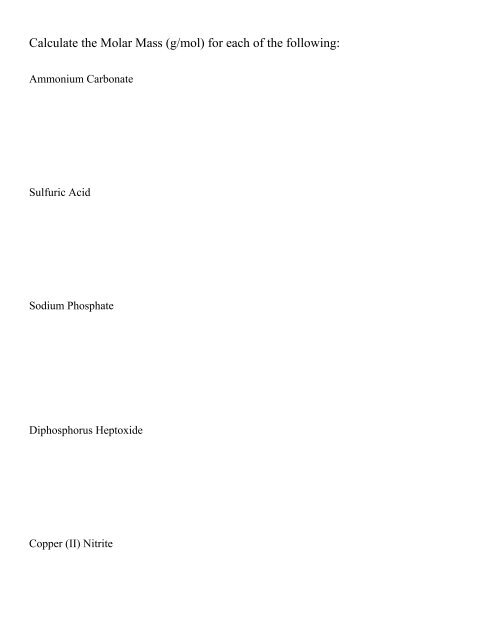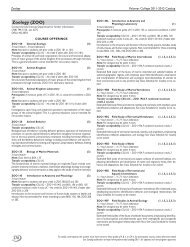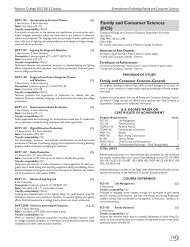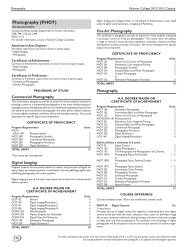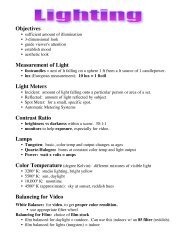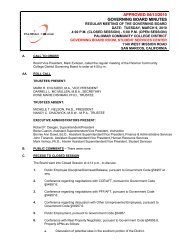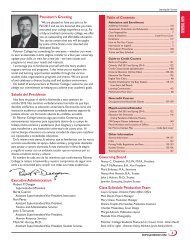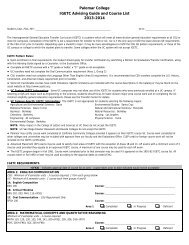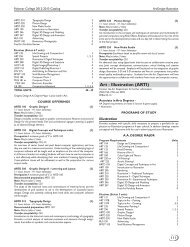Calculate the Molar Mass (g/mol) for each of the following:
Calculate the Molar Mass (g/mol) for each of the following:
Calculate the Molar Mass (g/mol) for each of the following:
Create successful ePaper yourself
Turn your PDF publications into a flip-book with our unique Google optimized e-Paper software.
<strong>Calculate</strong> <strong>the</strong> <strong>Molar</strong> <strong>Mass</strong> (g/<strong>mol</strong>) <strong>for</strong> <strong>each</strong> <strong>of</strong> <strong>the</strong> <strong>following</strong>:<br />
Ammonium Carbonate<br />
Sulfuric Acid<br />
Sodium Phosphate<br />
Diphosphorus Heptoxide<br />
Copper (II) Nitrite
<strong>Calculate</strong> <strong>the</strong> <strong>Mass</strong> Percent <strong>for</strong> <strong>each</strong> element in <strong>the</strong> compound:<br />
Ammonium Carbonate<br />
1. How many <strong>mol</strong>es <strong>of</strong> oxygen are in 9.85 g <strong>of</strong> (NH 4 ) 2 CO 3 ?<br />
2. How many hydrogen atoms are in 0.546 lb <strong>of</strong> (NH 4 ) 2 CO 3 ?<br />
3. How many grams <strong>of</strong> nitrogen are in a mass <strong>of</strong> (NH 4 ) 2 CO 3 that<br />
contains 1.23 x 10 23 carbon atoms?<br />
4. How many grams <strong>of</strong> (NH 4 ) 2 CO 3 are in <strong>the</strong> previous problem?
<strong>Calculate</strong> <strong>the</strong> <strong>Mass</strong> Percent <strong>for</strong> <strong>each</strong> element in <strong>the</strong> compound:<br />
Sodium Phosphate<br />
1. How many atoms <strong>of</strong> sodium are in 5.55 grams <strong>of</strong> Na 3 PO 4 ?<br />
2. How many grams <strong>of</strong> oxygen are in a mass <strong>of</strong> Na 3 PO 4 that contains 3.69<br />
<strong>mol</strong>es <strong>of</strong> phosphorus?<br />
3. How many grams <strong>of</strong> phosphorus are in a sodium phosphate <strong>mol</strong>ecule?<br />
4. How many oxygen atoms are in 4.75 <strong>mol</strong>es <strong>of</strong> sodium phosphate?
<strong>Mass</strong> ↔ Moles ↔ Atoms or Molecules<br />
Substance <strong>Mass</strong> <strong>of</strong> Sample Moles <strong>of</strong> Sample Atoms in Sample<br />
Silicon<br />
0.456 lb<br />
Boron<br />
8.21 <strong>mol</strong><br />
Manganese<br />
3.97 x 10 25 atoms<br />
Aluminum<br />
6.28 x 10 -2 kg<br />
Carbon<br />
5.87 <strong>mol</strong><br />
Chlorine<br />
4.92 x 10 22 atoms<br />
Substance <strong>Mass</strong> <strong>of</strong> Sample Moles <strong>of</strong> Sample Molecules in Sample<br />
Ammonium<br />
Carbonate<br />
5.92 g<br />
Sulfuric Acid<br />
0.987 <strong>mol</strong><br />
Sodium<br />
Phosphate<br />
2.58 x 10 23 <strong>mol</strong>ecules<br />
Acetic Acid<br />
400 mg<br />
Diphosphorus<br />
Heptoxide<br />
1.46 <strong>mol</strong><br />
Copper (II)<br />
Nitrite<br />
7.55 x 10 21 <strong>mol</strong>ecules
<strong>Mass</strong> ↔ Moles ↔ Atoms or Molecules…..Continued<br />
1. How many <strong>mol</strong>es <strong>of</strong> Silicon (Si) are in 12.00 grams <strong>of</strong> Silicon?<br />
2. How many atoms <strong>of</strong> Gold (Au) are in 25.5 ounces <strong>of</strong> Gold?<br />
3. How many grams <strong>of</strong> Iron (Fe) are in a sample <strong>of</strong> 99 x 10 25 Iron atoms?<br />
4. How many atoms <strong>of</strong> Oxygen (O) are in a 0.146 kilogram sample <strong>of</strong> Oxygen <strong>mol</strong>ecules<br />
(O 2 )?<br />
5. How many kilograms <strong>of</strong> Titanium (Ti) are in a sample <strong>of</strong> 5.0 x 10 26 Titanium (IV)<br />
Phosphate <strong>mol</strong>ecules?<br />
6. How many atoms <strong>of</strong> Sodium (Na) are in a 3.870 gram sample <strong>of</strong> Sodium Oxalate?
Turquoise: CuAl 6 (PO 4 ) 4 (OH) 8 ·4H 2 O<br />
1) What is <strong>the</strong> total number <strong>of</strong> atoms in a 5.00 gram sample <strong>of</strong> turquoise?<br />
2) How many water <strong>mol</strong>ecules are <strong>the</strong>re in a sample <strong>of</strong> turquoise with a mass <strong>of</strong> 10 grams?<br />
3) What mass <strong>of</strong> turquoise (in milligrams) contains 3.75 x 10 22 atoms <strong>of</strong> oxygen?<br />
4) How many phosphate ions are in a sample <strong>of</strong> turquoise that contains 435 micrograms <strong>of</strong><br />
hydrogen?<br />
5) What is <strong>the</strong> mass <strong>of</strong> hydrogen in a sample <strong>of</strong> turquoise that contains 3.50 milligrams <strong>of</strong><br />
oxygen(O)?
Acetaminophen: C 8 H 9 O 2 N is <strong>the</strong> painkilling ingredient in Tylenol products<br />
1) What is <strong>the</strong> <strong>mol</strong>ar mass <strong>of</strong> acetaminophen?<br />
2) How many hydrogen atoms are in 25.00 grams <strong>of</strong> acetaminophen?<br />
3) How many grams <strong>of</strong> carbon are in 10.55 grams <strong>of</strong> acetaminophen?<br />
4) What is <strong>the</strong> % composition by mass <strong>of</strong> carbon and nitrogen in <strong>the</strong> <strong>mol</strong>ecule?<br />
5) How many grams <strong>of</strong> oxygen are in a sample <strong>of</strong> acetaminophen that contains 9.64 x 10 26<br />
carbon atoms?
Molecular Formulas<br />
1) The compound ferrocene is known to contain 64.56% carbon, 5.42% hydrogen and some<br />
iron. The <strong>mol</strong>ar mass <strong>of</strong> ferrocene is ~190 g/<strong>mol</strong>. What is <strong>the</strong> <strong>mol</strong>ecular <strong>for</strong>mula <strong>of</strong><br />
ferrocene?<br />
2) A compound contains only carbon, hydrogen and oxygen. Combustion <strong>of</strong> 10.68 mg <strong>of</strong> <strong>the</strong><br />
compound yields 16.01 mg <strong>of</strong> carbon dioxide and 4.37 mg <strong>of</strong> water. The <strong>mol</strong>ar mass <strong>of</strong><br />
<strong>the</strong> compound is 176.1 g/<strong>mol</strong>. What is <strong>the</strong> <strong>mol</strong>ecular <strong>for</strong>mula <strong>of</strong> <strong>the</strong> compound?
Combustion Reactions<br />
Propane, C 3 H 8 , is a fuel commonly used <strong>for</strong> heating in rural areas where natural gas is<br />
unavailable.<br />
1) Write <strong>the</strong> balanced equation <strong>for</strong> <strong>the</strong> combustion <strong>of</strong> propane:<br />
2) <strong>Calculate</strong> <strong>the</strong> mass (in grams) <strong>of</strong> carbon dioxide that will be produced from <strong>the</strong> burning <strong>of</strong><br />
25.00 grams <strong>of</strong> propane. *Assume excess oxygen*<br />
3) <strong>Calculate</strong> <strong>the</strong> mass (in grams) <strong>of</strong> dihydrogen monoxide that will be produced from <strong>the</strong><br />
burning <strong>of</strong> 25.00 grams <strong>of</strong> propane. *Assume excess oxygen*<br />
4) If 3.75 <strong>mol</strong>es <strong>of</strong> carbon dioxide were produced (in ano<strong>the</strong>r combustion <strong>of</strong> propane<br />
reaction), how many oxygen atoms were consumed in <strong>the</strong> process?


